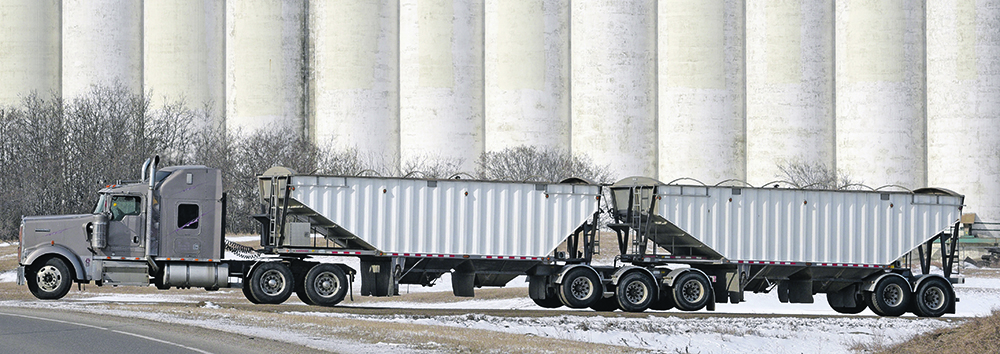Prairie producers are making it a habit to head south of the border to sell their grain, according to the federal grain monitor
Trucking grain from Western Canada to the United States is on the rise and likely to continue, says the company that monitors prairie grain handling and transportation.
About 3.2 million tonnes of prairie grain were trucked to U.S. buyers in 2014-15, almost double the amount in 2012-13.
“You can see this is slowly growing,” said Mark Hemmes, president of Quorum Corp., the government appointed grain monitor.
“This is something, as we go forward, trucking into the U.S. is going to keep creeping up.”
Read Also

Bunge’s crop mix is changing
Bunge has predominantly been a soybean processing firm, but that’s about to change after the merger with Viterra with softseed processing and grain merchandising gaining ground.
The 3.2 million tonnes represents six percent of prairie crop production in 2014-15.
Some observers think direct U.S. sales are a natural as the border becomes less of an obstacle but others believe market specifics, such as exchange rates, will determine year to year how many trucks head south.
Jonathan Driedger, market analyst with Farm Link Marketing Solutions, said the trucking stats aren’t surprising because many prairie producers sold grain to U.S. buyers in the winter of 2013-14.
There was a glut of grain on the Prairies during the 2013-14 crop year. Country elevators weren’t buying or would buy only at extremely wide basis levels, forcing producers to explore other options, such as the U.S.
Driedger said that first sale, in 2014, may have turned into a habit.
“It’s not a surprise to me that the (trucking) number is going up. I’m seeing it with clients,” he said from his office in Grunthal, Man.
“Once you’ve done it once or twice it becomes a little more comfortable. Relationships get established, and supply chains become more established.”
The boom in soybean production in Manitoba and Saskatchewan may be pushing truck shipments higher because a large chunk of the prairie soybean crop is sold to the U.S.
Soybean production in Manitoba and Saskatchewan has increased from 770,000 tonnes in 2012 to 1.57 million tonnes in 2015.
Brian Voth, an Agri-Trend marketing adviser in Manitoba’s Red River Valley, isn’t witnessing the trucking trend with his clients.
Many producers he knows moved wheat and other commodities south during the 2013-14 crop year, but the volumes have declined the last couple of years.
Canadian grain companies have been more competitive in bids and basis levels this crop year because they don’t want to lose business to U.S. competitors.
“This year there’s been a real drop off (in trucking),” Voth said.
“With the dollar being where it is, buyers on this side of the border (are) offering quite a bit better basis levels…. The Canadian elevators still want that handle because every time they don’t handle is lost revenue.”
Voth said the response of Canadian companies was expected because a substantial difference in grain prices between the two countries was not sustainable.
Driedger agreed that Canadian grain merchants are now willing to pay more to attract clients.
“We’ve got less grain in Western Canada this year, so there’s more competition to handle what is out there,” he said.
“You’re seeing companies willing to handle grain for less (money) then they had before.”
However, the weak loonie may encourage more producers to consider the U.S. market.
“Wheat is probably the biggest swing factor,” Voth said.
“With the high quality wheat we had this year, going south is probably easier… because there’s no problem hitting their specs.”
Another factor is the paperwork and logistics associated with a U.S. grain sale. That is becoming easier because grain brokers will take care of the details for a “few bucks per tonne,” Driedger said.
Quorum Corp. will have interim grain trucking data for 2015-16 later this year.
















